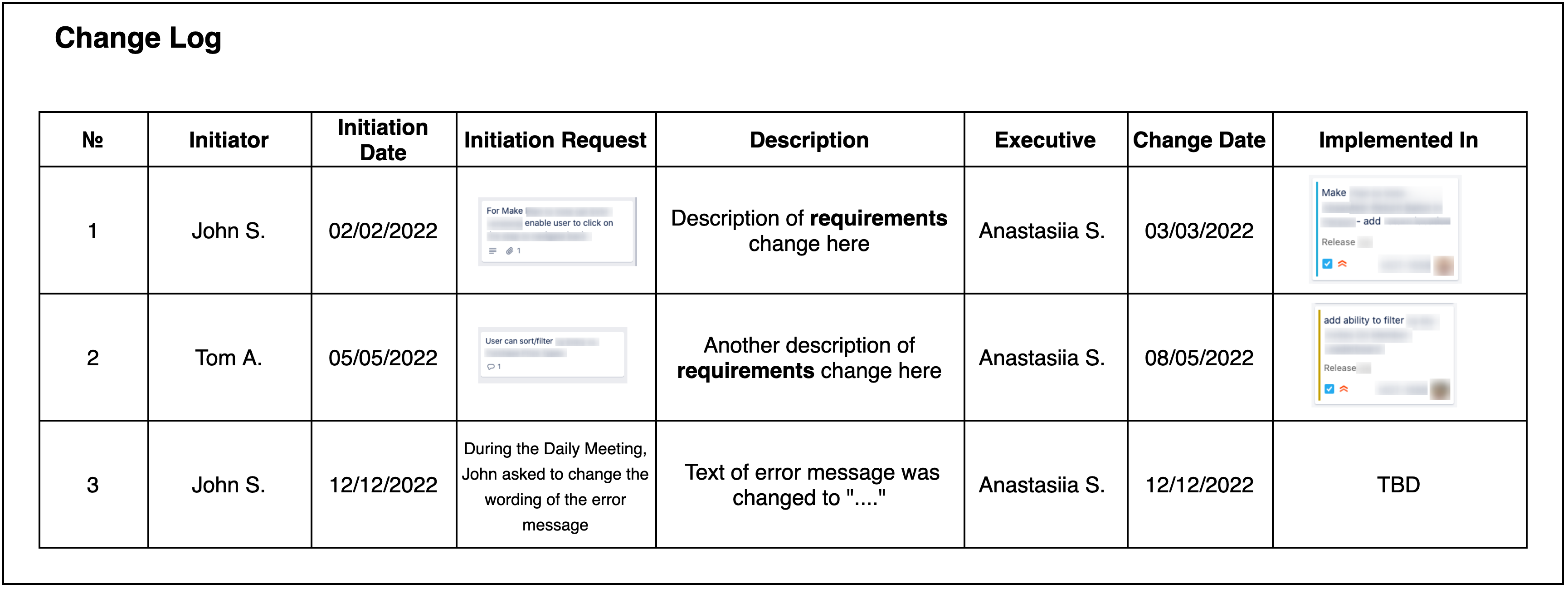Managing Requirements Changes: Practical Case of Documentation
In today's fast-paced business environment, requirements management is a crucial aspect of any successful project. And talking about IT startups, such kind of projects are known for their dynamic nature. As a result, their requirements can change quickly and frequently.
To deal with these challenges, any IT projects may need to be agile and flexible, with the ability to pivot quickly and iterate on their products and services as needed. These changes can have a significant impact on the overall project, and it is important to have a clear and efficient process for documenting and addressing them. It involves the process of identifying, documenting, and tracking the requirements that a project must meet in order to be successful.
The reasons why the requirements for the IT project may change
There are many reasons why requirements for an IT project could change. A few widespread reasons include:
- Changes in business needs: The business environment is constantly changing, and as a result, the needs and goals of the business may change as well.
- Changes in technology: As new technologies emerge, the project requirements may need to be updated to take advantage of these advances.
- Changes in project scope: The scope of the project may change as the project progresses, either due to changes in the project's goals or because new information becomes available.
- Changes in project constraints: If the budget for the project changes, or if the timeline for the project needs to be adjusted, this could necessitate changes to the requirements.
- Changes in project team: If there are changes in the composition of the project team, such as new team members or changes in leadership, this could lead to changes in the requirements for the project.
- Changes in end-user needs: The needs of the users of the system may change over time, requiring updates to the project requirements.
- Stakeholder feedback: As the project progresses, stakeholders may provide feedback that leads to changes in the requirements for the project.
- Unforeseen challenges: It is not uncommon for unforeseen challenges to arise during the course of an IT project.
It is important for the project team to have a process in place for managing changes to the project requirements, to ensure that the project stays on track and delivers the desired outcomes.
Effective requirements change management in software engineering
One of the aspects of change management is documenting changes in a clear and organized way, so that every stakeholder involved in a project has a clear understanding of what has changed and why. Here are a few recommendation you can follow to document changing requirements effectively:
- Use a standardized format: It's helpful to use a consistent format for documenting changes to requirements, such as a change request template or form. This makes it easy to track and understand the changes that have been made.
- Identify the requirement being changed: Clearly identify the requirement that is being changed, including its unique identifier (if applicable) and a brief description of the requirement.
- Explain the reason for the change: Clearly explain the reason for the change, including any external factors that may have influenced the change (such as a change in business needs or customer feedback).
- Document the proposed change: Describe the proposed change in detail, including any updates or modifications to the requirement.
- Include supporting information: If applicable, include any supporting information or documentation (such as mockups or user research) that helped to inform the change.
- Obtain approval for the change: It's important to obtain approval for changes to requirements, especially if the change is significant. This can be done through a formal review process or by obtaining sign-off from relevant stakeholders.
- Update project documentation: Once the change has been approved, make sure to update any relevant project documentation (such as the project charter or requirements specification) to reflect the change.
How to document change requirements
There are several approaches that could be used to document change requirements:
- Use a change request template: This is a standardized document that outlines the necessary information for requesting a change. It typically includes fields for the change requestor, the reason for the change, the impact of the change, and any necessary approvals.
- Create a change request form: This is a more detailed version of the change request template. It can include additional fields for specifying the scope of the change, the resources required, and the expected outcomes.
- Use a change management software tool: These tools allow you to track and manage change requests in a centralized location. They typically include features for routing requests for review and approval, as well as for tracking the status of the change throughout the process.
- Use a project management software tool: These tools allow you to manage the entire change process, including the documentation of requirements. They typically include features for tracking project tasks, resources, and deadlines.
Regardless of the chosen approach, it's important to make sure that the documentation is clear, concise, and easy to understand. It should also be accessible to all relevant stakeholders, so that everyone is aware of the changes being made and the impact they will have.
Change requirements logs
It is very necessary to control that changes were applied to the original documentation, because it may have been overlooked due to in most cases human factors, for instance, due to an excessive workload. At Software Development Hub on the majority of projects it is a common practice to use the change requirements logs.
A change requirements log is a document that tracks and records changes made to a system, project or feature. It typically includes information about the change, the reason for the change, the person or group responsible for the change, and any relevant documentation or resources related to the change. The log is used to keep track of changes made over time and can be used to identify trends or patterns, assess the impact of changes, and ensure that changes are properly documented and communicated to relevant stakeholders. In our estimation, it is an important tool for managing and maintaining the integrity and quality of a system or project. Here is a sample of the change requirements log.

Sample of change requirements log
This log is usually placed at the end of a document (e.g., a requirements management system), where specific requirements are described and stored.
The main components of this log are:
- ID of the change.
- Initiator: The stakeholder initiated the change.
- Initiation date: The date the change was initiated.
- Initiation request: How the need for change arose; this could be a reference to the source, the context.
- Description: A description of the change that was made; this should be detailed enough to provide a clear understanding of what was changed.
- Executive: The internal stakeholder who is responsible for the change (made the change in the documentation).
- Initiation date: The date the change in documentation was made.
- Implemented in: How the change was implemented in the system; this could be, for instance, an URL to project management tool and task.
It is worth noting that this log refers specifically to changes in requirements documentation, and not to the monitoring of the implementation of changes in features.
We have found that maintaining a change log can have several benefits and drawbacks.
Pros:
- A change log helps to track changes made to a project over time. This can be useful for debugging, as it allows developers to see what changes were made and when they were made.
- A change log can serve as a reference for team members, helping them to understand the history of the project and how it has evolved.
- A change log can also be useful for stakeholders, such as clients or users, as it provides a clear record of the changes that have been made and the reasons for making those changes.
Cons:
- Maintaining a change log can be time-consuming, as it requires documentation of each change as it is made.
- A change log can become large and unwieldy over time, making it difficult to navigate and understand.
- If the change log is not kept up to date, it may not be accurate or useful.
Eventually, the pros of maintaining a change log generally outweigh the cons, especially for large or complex projects. However, it is important to strike a balance between the benefits of having a comprehensive change log and the time and effort required to maintain it.
Categories
About the author
Share
Need a project estimate?
Drop us a line, and we provide you with a qualified consultation.








